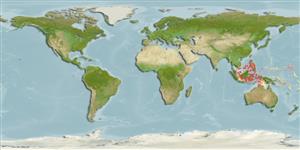>
Gobiiformes (Gobies) >
Gobiidae (Gobies) > Gobiinae
Etymology: Trimma: Greek, trimma, -atos = something crushed (Ref. 45335); corerefum: Name from the arbitrary combination of letters reflecting the Coral Reef ResearchFoundation in Palau and is pronounced 'core-ref-um'; an organization, established and operated by Pat and Lori Colin; noun in apposition..
Environment: milieu / climate zone / depth range / distribution range
Ecologia
marino; distribuzione batimetrica 10 - 30 m (Ref. 109919), usually 12 - 30 m (Ref. 109919). Tropical
Distribuzione
Stati | Aree FAO | Ecosystems | Presenze | Point map | Introduzioni | Faunafri
Western Pacific: Palau, Indonesia and the Philippines.
Size / Peso / Age
Maturity: Lm ? range ? - ? cm
Max length : 1.7 cm SL maschio/sesso non determinato; (Ref. 109919); 1.9 cm SL (female)
Short description
Morfologia | Morfometria
Spine dorsali (totale): 7; Raggi dorsali molli (totale): 8; Spine anali 1; Raggi anali molli: 8. This species is distinguished by the following characters: possess a bony interorbital about three-quarters pupil diameter (68-85%), with a fully scaled nape, the anterior rows cycloid in adults, a second dorsal spine that usually reaches middle of the second dorsal fin; two cephalic sensory papillae in row f on the chin and in row r on the top of the snout, 2-5 (usually 4) papillae in row d? immediately behind the maxilla, usually 13 (range = 12-14) unbranched pectoral-fin rays, and an unbranched fifth pelvic-fin ray that is 34-45% the length of the fourth ray. Colour of freshly collected specimens: reddish head and anterior nape except below a line bounded by the horizontal limb of preopercle, where these are white; red opercular region and abdomen with a liberal sprinkling of large, dark brown melanophores, a pupil-diameter wide white band across peduncle anterior to the caudal spot, approximately pupil diameter dark marking on the posterior part of the peduncle and extending onto the bases of the caudal fin rays; preserved specimens with four distinct groupings of small round black melanophores situated at the 3, 4:30, 6 and 9 o’clock positions around the eye (Ref. 109919).
Occurs in vertical wall with small caves, overhangs and crevices, hard corals (<>iAcropora, Montipora), hydroids, and sea fans (Ref. 109919).
Life cycle and mating behavior
Maturità | Riproduzione | Deposizione | Uova | Fecundity | Larve
Winterbottom, R., 2016. Trimma tevegae and T. caudomaculatum revisited and redescribed (Acanthopterygii, Gobiidae), with descriptions of three new similar species from the western Pacific. Zootaxa 4144(1):001-053. (Ref. 109919)
IUCN Red List Status (Ref. 130435)
Threat to humans
Harmless
Human uses
Informazioni ulteriori
Nomi ComuniSinonimiMetabolismoPredatoriEcotossicologiaRiproduzioneMaturitàDeposizioneSpawning aggregationFecundityUovaEgg development
Age/SizeAccrescimentoLength-weightLength-lengthLength-frequenciesMorfometriaMorfologiaLarveDinamica popolazioni larvaliReclutamentoAbbondanzaBRUVS
BibliografiaAcquacolturaProfilo di acquacolturaVarietàGeneticaElectrophoresesEreditarietàMalattieElaborazioneNutrientsMass conversion
CollaboratoriImmaginiStamps, Coins Misc.SuoniCiguateraVelocitàModalità di nuotoArea branchialeOtolithsCervelliVista
Strumenti
Special reports
Download XML
Fonti Internet
Estimates based on models
Phylogenetic diversity index (Ref.
82804): PD
50 = 0.5000 [Uniqueness, from 0.5 = low to 2.0 = high].
Bayesian length-weight: a=0.00708 (0.00333 - 0.01504), b=3.09 (2.92 - 3.26), in cm total length, based on LWR estimates for this (Sub)family-body shape (Ref.
93245).
Resilienza (Ref.
120179): Alto, tempo minimo di raddoppiamento della popolazione meno di 15 mesi (Preliminary K or Fecundity.).
Fishing Vulnerability (Ref.
59153): Low vulnerability (10 of 100).
